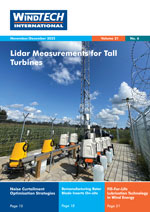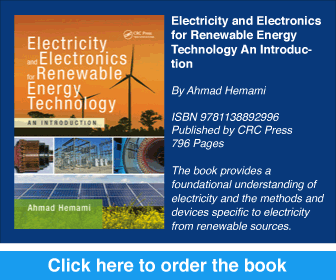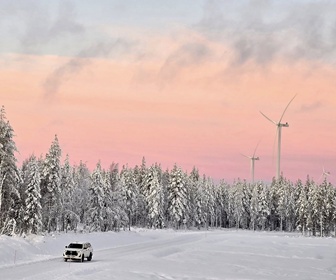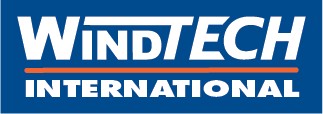- Category: Articles
Turbulence Intensity Becomes a Key Factor When Planning Wind Farms
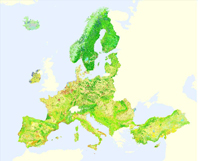 Wind power plays a substantial part in worldwide plans to increase renewable energy utilisation. In future existing wind farms will need to be repowered and new wind farm sites are going to need to be explored. However, in countries like Germany new sites are becoming rare and there is a limit to the amount of energy that can be generated from a given area. When placing wind turbines too close together turbulence generated by the wakes of the wind turbines may seriously affect their structural integrity and so becomes a limiting factor in wind farm layouts. This holds especially true for complex terrain, where the terrain-generated turbulence makes a significant contribution to the overall load.
Wind power plays a substantial part in worldwide plans to increase renewable energy utilisation. In future existing wind farms will need to be repowered and new wind farm sites are going to need to be explored. However, in countries like Germany new sites are becoming rare and there is a limit to the amount of energy that can be generated from a given area. When placing wind turbines too close together turbulence generated by the wakes of the wind turbines may seriously affect their structural integrity and so becomes a limiting factor in wind farm layouts. This holds especially true for complex terrain, where the terrain-generated turbulence makes a significant contribution to the overall load.
By Thomas Hahm, F2E Fluid & Energy Engineering, Germany
 Wind power plays a substantial part in worldwide plans to increase renewable energy utilisation. In future existing wind farms will need to be repowered and new wind farm sites are going to need to be explored. However, in countries like Germany new sites are becoming rare and there is a limit to the amount of energy that can be generated from a given area. When placing wind turbines too close together turbulence generated by the wakes of the wind turbines may seriously affect their structural integrity and so becomes a limiting factor in wind farm layouts. This holds especially true for complex terrain, where the terrain-generated turbulence makes a significant contribution to the overall load.
Wind power plays a substantial part in worldwide plans to increase renewable energy utilisation. In future existing wind farms will need to be repowered and new wind farm sites are going to need to be explored. However, in countries like Germany new sites are becoming rare and there is a limit to the amount of energy that can be generated from a given area. When placing wind turbines too close together turbulence generated by the wakes of the wind turbines may seriously affect their structural integrity and so becomes a limiting factor in wind farm layouts. This holds especially true for complex terrain, where the terrain-generated turbulence makes a significant contribution to the overall load.By Thomas Hahm, F2E Fluid & Energy Engineering, Germany
- Category: Articles
Uncertainty of Wind Power Production
Uncertainty of the annual energy production of wind parks is a key figure for the bankability of a wind energy project. Uncertainties are known as levels of exceedance or P-values. The estimation of uncertainties follows the rules of error propagation. Common assumptions considerably underestimate the level of exceedance and should be revised.
By Dr Johannes Sander, Sander + Partner, Switzerland
Uncertainty of the annual energy production of wind parks is a key figure for the bankability of a wind energy project. Uncertainties are known as levels of exceedance or P-values. The estimation of uncertainties follows the rules of error propagation. Common assumptions considerably underestimate the level of exceedance and should be revised.
By Dr Johannes Sander, Sander + Partner, Switzerland
- Category: Articles
Korea’s Jeju Smart Grid Test-bed
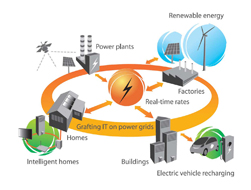 Korea is pursuing sustainable development while dealing with climate change. It is also moving towards a low carbon economy and a society capable of recovering from climate change. As part of these efforts, Korea has launched a Smart Grid national project to achieve green growth in a transparent, comprehensive, effective and efficient way. With these plans in mind, Korea has started building a Smart Grid Test-bed on Jeju Island to prove its determination to make the low-carbon, green-growth strategy succeed.
Korea is pursuing sustainable development while dealing with climate change. It is also moving towards a low carbon economy and a society capable of recovering from climate change. As part of these efforts, Korea has launched a Smart Grid national project to achieve green growth in a transparent, comprehensive, effective and efficient way. With these plans in mind, Korea has started building a Smart Grid Test-bed on Jeju Island to prove its determination to make the low-carbon, green-growth strategy succeed.
By Mr Kim Jea-Seob, Chief Executive Officer of Korea Smart Grid Institute, South Korea
 Korea is pursuing sustainable development while dealing with climate change. It is also moving towards a low carbon economy and a society capable of recovering from climate change. As part of these efforts, Korea has launched a Smart Grid national project to achieve green growth in a transparent, comprehensive, effective and efficient way. With these plans in mind, Korea has started building a Smart Grid Test-bed on Jeju Island to prove its determination to make the low-carbon, green-growth strategy succeed.
Korea is pursuing sustainable development while dealing with climate change. It is also moving towards a low carbon economy and a society capable of recovering from climate change. As part of these efforts, Korea has launched a Smart Grid national project to achieve green growth in a transparent, comprehensive, effective and efficient way. With these plans in mind, Korea has started building a Smart Grid Test-bed on Jeju Island to prove its determination to make the low-carbon, green-growth strategy succeed.By Mr Kim Jea-Seob, Chief Executive Officer of Korea Smart Grid Institute, South Korea
- Category: Articles
A Significant Leap Forward
 Wind power engineering has tended to be a fairly conservative area of industry. No one expects any significant new design ideas that radically improve the feasibility and performance characteristics of horizontal axis wind turbines (HAWTs). Most current changes in the design and construction of rotor blades are brought about by new technologies and materials with higher strength characteristics. This ensures higher reliability and extends their service life. Such things as the amount of energy that can be extracted from the wind flow as it moves through a defined swept area have remained more or less unchanged for many years. However, the Latvian company SIA Latekols has found a way to substantially improve wind turbine performance.
Wind power engineering has tended to be a fairly conservative area of industry. No one expects any significant new design ideas that radically improve the feasibility and performance characteristics of horizontal axis wind turbines (HAWTs). Most current changes in the design and construction of rotor blades are brought about by new technologies and materials with higher strength characteristics. This ensures higher reliability and extends their service life. Such things as the amount of energy that can be extracted from the wind flow as it moves through a defined swept area have remained more or less unchanged for many years. However, the Latvian company SIA Latekols has found a way to substantially improve wind turbine performance.
By Grigory Fedotov, SIA Latekols, Latvia
 Wind power engineering has tended to be a fairly conservative area of industry. No one expects any significant new design ideas that radically improve the feasibility and performance characteristics of horizontal axis wind turbines (HAWTs). Most current changes in the design and construction of rotor blades are brought about by new technologies and materials with higher strength characteristics. This ensures higher reliability and extends their service life. Such things as the amount of energy that can be extracted from the wind flow as it moves through a defined swept area have remained more or less unchanged for many years. However, the Latvian company SIA Latekols has found a way to substantially improve wind turbine performance.
Wind power engineering has tended to be a fairly conservative area of industry. No one expects any significant new design ideas that radically improve the feasibility and performance characteristics of horizontal axis wind turbines (HAWTs). Most current changes in the design and construction of rotor blades are brought about by new technologies and materials with higher strength characteristics. This ensures higher reliability and extends their service life. Such things as the amount of energy that can be extracted from the wind flow as it moves through a defined swept area have remained more or less unchanged for many years. However, the Latvian company SIA Latekols has found a way to substantially improve wind turbine performance. By Grigory Fedotov, SIA Latekols, Latvia
- Category: Articles
Making Space for Offshore Wind Power
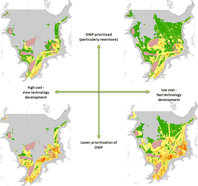 The European project ‘WindSpeed’ concluded that there is a need for a more collaborative and integrated approach and cross-border coordination, in order to fulfil the high offshore wind ambitions of the UK, Denmark, the Netherlands, Norway, Belgium and Germany.
The European project ‘WindSpeed’ concluded that there is a need for a more collaborative and integrated approach and cross-border coordination, in order to fulfil the high offshore wind ambitions of the UK, Denmark, the Netherlands, Norway, Belgium and Germany.
By Chris Westra, Energy Research Centre of the Netherlands
 The European project ‘WindSpeed’ concluded that there is a need for a more collaborative and integrated approach and cross-border coordination, in order to fulfil the high offshore wind ambitions of the UK, Denmark, the Netherlands, Norway, Belgium and Germany.
The European project ‘WindSpeed’ concluded that there is a need for a more collaborative and integrated approach and cross-border coordination, in order to fulfil the high offshore wind ambitions of the UK, Denmark, the Netherlands, Norway, Belgium and Germany.By Chris Westra, Energy Research Centre of the Netherlands
- Category: Articles
Highlights from the 2010 Wind Energy Buy-Chain Survey
In the midst of difficult economic conditions, the US wind power industry faced significant difficulties in 2010. Installations were hindered by factors such as ongoing challenges in securing project financing, low natural gas prices favouring gas-fired generation, and decreased electricity demand caused by the recession. In total, the USA added 5,115MW of wind capacity in 2010, about half the total of installations added in the previous year (American Wind Energy Association). Such a rapid drop in one year, especially following a stretch of 39% compound annual growth over the previous five years, would shake many industries to their core. What are US wind industry manufacturers and service companies looking for now?
By Tim Kumbier, Loch McCabe and Terri Schroeder, Shepherd Advisors, USA
In the midst of difficult economic conditions, the US wind power industry faced significant difficulties in 2010. Installations were hindered by factors such as ongoing challenges in securing project financing, low natural gas prices favouring gas-fired generation, and decreased electricity demand caused by the recession. In total, the USA added 5,115MW of wind capacity in 2010, about half the total of installations added in the previous year (American Wind Energy Association). Such a rapid drop in one year, especially following a stretch of 39% compound annual growth over the previous five years, would shake many industries to their core. What are US wind industry manufacturers and service companies looking for now?
By Tim Kumbier, Loch McCabe and Terri Schroeder, Shepherd Advisors, USA
- Category: Articles
Structural Solutions to Save Weight in Future Blades
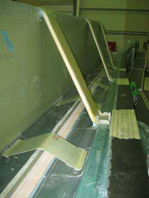 Recent work at Risø DTU on wind turbine blades has shown that more failure mechanisms need to be taken into account than just the classical ones such as buckling, material failure, etc. An example of one of the failure modes, which is not part of a certification process, is the non-linear out-of-plane deformation of the load-carrying cap laminate, which introduces interlaminar shear stresses in the load-carrying laminate. This could be the reason for some of the failures in today’s wind turbine blades. This failure mechanism is taken into account in the design of a new, innovative 40m load-carrying box girder presented in this article.
Recent work at Risø DTU on wind turbine blades has shown that more failure mechanisms need to be taken into account than just the classical ones such as buckling, material failure, etc. An example of one of the failure modes, which is not part of a certification process, is the non-linear out-of-plane deformation of the load-carrying cap laminate, which introduces interlaminar shear stresses in the load-carrying laminate. This could be the reason for some of the failures in today’s wind turbine blades. This failure mechanism is taken into account in the design of a new, innovative 40m load-carrying box girder presented in this article.
By Find M. Jensen, Risø National Laboratory for Sustainable Energy, Denmark
 Recent work at Risø DTU on wind turbine blades has shown that more failure mechanisms need to be taken into account than just the classical ones such as buckling, material failure, etc. An example of one of the failure modes, which is not part of a certification process, is the non-linear out-of-plane deformation of the load-carrying cap laminate, which introduces interlaminar shear stresses in the load-carrying laminate. This could be the reason for some of the failures in today’s wind turbine blades. This failure mechanism is taken into account in the design of a new, innovative 40m load-carrying box girder presented in this article.
Recent work at Risø DTU on wind turbine blades has shown that more failure mechanisms need to be taken into account than just the classical ones such as buckling, material failure, etc. An example of one of the failure modes, which is not part of a certification process, is the non-linear out-of-plane deformation of the load-carrying cap laminate, which introduces interlaminar shear stresses in the load-carrying laminate. This could be the reason for some of the failures in today’s wind turbine blades. This failure mechanism is taken into account in the design of a new, innovative 40m load-carrying box girder presented in this article.By Find M. Jensen, Risø National Laboratory for Sustainable Energy, Denmark
Use of cookies
Windtech International wants to make your visit to our website as pleasant as possible. That is why we place cookies on your computer that remember your preferences. With anonymous information about your site use you also help us to improve the website. Of course we will ask for your permission first. Click Accept to use all functions of the Windtech International website.



